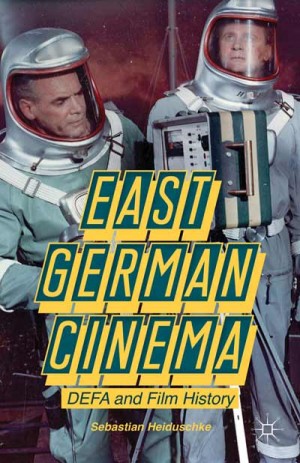21. Oktober 2014
East German Cinema
 Sebastian Heiduschke, Assistant Professor of Foreign Languages and Literatures an der Oregon State University in Corvallis, USA, nennt zu Beginn seiner Einleitung die Zielgruppe des Buches: „If you are a novice to East German Cinema, this book is for you.“ Aber auch für Leser, die mit dem DEFA-Film vertraut sind, enthält die Publikation viele im Rückblick interessante Einschätzungen zur Geschichte des DDR-Films. Nach einem 30-Seiten-Essay zur Institution DEFA konkretisiert der Autor seine Einführung an zwölf Filmbeispielen: DIE MÖRDER SIND UNTER UNS, 1946 („The Rubble Film, Wolfgang Staudte, and Postwar German Cinema“), DIE GESCHICHTE VOM KLEINEN MUCK, 1953 („Faity Tales and Children’s Films as Eternal Blockbusters“), BERLIN – ECKE SCHÖNHAUSER…, 1957 („The Gegenwartsfilm, West Berlin as Hostile Other, and East Germany as Homeland“), DER SCHWEIGENDE STERN,1960 („The Birth of DEFA Genre Cinema, East German Sci-fi Films, New Technologies, and Coproduction with East Europe“), DAS KANINCHEN BIN ICH, 1965 („Film Censorship, the East German Nouvelle Vague, and the ‚Rabbit Film’“), HEISSER SOMMER, 1968 (Renegade Films, DEFA Musicals, and the Genre Cinema“), APACHEN, 1973 („More Genre Cinema, the ‚Red Western’, and Stardom in East Germany“), DIE LEGENDE VON PAUL UND PAULA, 1973 („Gender, Class, and Sexuality“), JAKOB DER LÜGNER, 1974 („DEFA and the Holocaust, the Antifacist Legacy, and International Acclaim“), SOLO SUNNY, 1980 („The Women’s Film, Konrad Wolf, and DEFA after the ‚Biermann Affair’“), DIE ARCHITEKTEN, 1990 („Passed by History: Dystopia, Parable, and Bookend“), LETZTES AUS DER Da-Da-eR, 1990 („The Wendeflicks, Jörg Foth, and DEFA after Censorship“). Zu jedem Film gibt es eine gut begründete Abbildung, am Ende findet man eine Bibliografie mit Hinweisen auf weiterführende deutsch- und englischsprachige Literatur. Coverfoto: DER SCHWEIGENDE STERN. Mehr zum Buch: 9781137322319
Sebastian Heiduschke, Assistant Professor of Foreign Languages and Literatures an der Oregon State University in Corvallis, USA, nennt zu Beginn seiner Einleitung die Zielgruppe des Buches: „If you are a novice to East German Cinema, this book is for you.“ Aber auch für Leser, die mit dem DEFA-Film vertraut sind, enthält die Publikation viele im Rückblick interessante Einschätzungen zur Geschichte des DDR-Films. Nach einem 30-Seiten-Essay zur Institution DEFA konkretisiert der Autor seine Einführung an zwölf Filmbeispielen: DIE MÖRDER SIND UNTER UNS, 1946 („The Rubble Film, Wolfgang Staudte, and Postwar German Cinema“), DIE GESCHICHTE VOM KLEINEN MUCK, 1953 („Faity Tales and Children’s Films as Eternal Blockbusters“), BERLIN – ECKE SCHÖNHAUSER…, 1957 („The Gegenwartsfilm, West Berlin as Hostile Other, and East Germany as Homeland“), DER SCHWEIGENDE STERN,1960 („The Birth of DEFA Genre Cinema, East German Sci-fi Films, New Technologies, and Coproduction with East Europe“), DAS KANINCHEN BIN ICH, 1965 („Film Censorship, the East German Nouvelle Vague, and the ‚Rabbit Film’“), HEISSER SOMMER, 1968 (Renegade Films, DEFA Musicals, and the Genre Cinema“), APACHEN, 1973 („More Genre Cinema, the ‚Red Western’, and Stardom in East Germany“), DIE LEGENDE VON PAUL UND PAULA, 1973 („Gender, Class, and Sexuality“), JAKOB DER LÜGNER, 1974 („DEFA and the Holocaust, the Antifacist Legacy, and International Acclaim“), SOLO SUNNY, 1980 („The Women’s Film, Konrad Wolf, and DEFA after the ‚Biermann Affair’“), DIE ARCHITEKTEN, 1990 („Passed by History: Dystopia, Parable, and Bookend“), LETZTES AUS DER Da-Da-eR, 1990 („The Wendeflicks, Jörg Foth, and DEFA after Censorship“). Zu jedem Film gibt es eine gut begründete Abbildung, am Ende findet man eine Bibliografie mit Hinweisen auf weiterführende deutsch- und englischsprachige Literatur. Coverfoto: DER SCHWEIGENDE STERN. Mehr zum Buch: 9781137322319